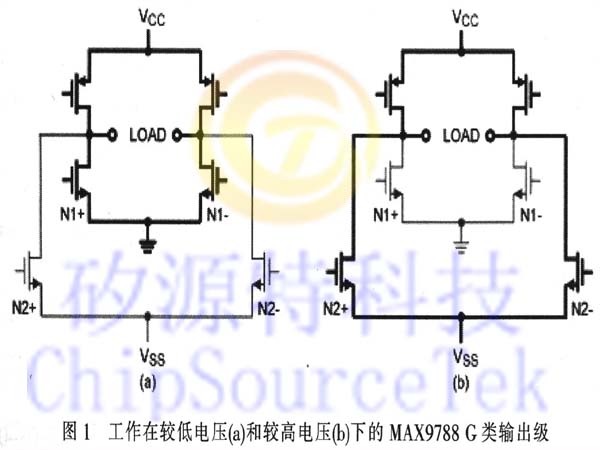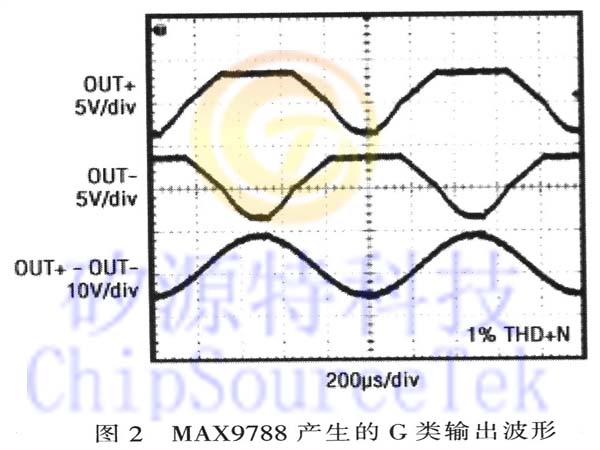Application of Charge Pump Technology (Non Inductive Boost) in Class G Amplifiers
Time:2023-05-29
Views:1011
1 Introduction
There is a common problem in portable audio applications, which is the limited power supply voltage of the speaker amplifier. These audio systems are typically powered by lithium-ion (Li+) batteries with an output rating of 3.7 V. Although a 3.7 V power supply is sufficient to ensure the normal operation of most components of the system, in order to provide satisfactory sound pressure, the speaker amplifier requires a higher power supply voltage. Therefore, the power stage of most speaker amplifiers adopts a bridge load configuration to generate twice the power supply voltage on the speakers.
In most cases, doubling the speaker power supply voltage is sufficient to meet the requirements, but some applications require higher output power. For example, piezoelectric speakers (requiring higher voltage drive) or systems that require higher sound pressure (such as GPS devices). The only solution for these audio applications is to increase the power supply voltage, which typically requires a separate DC-DC boost converter, thereby increasing the cost and complexity of the system.
The G-class amplifiers MAX9730 and MAX9788 use charge pumps to increase the power supply voltage to solve the power supply voltage problem. The MAX9730 is suitable for traditional dynamic speakers, while the MAX9788 is suitable for ceramic speakers.
2 Innovative charge pumps
Compared to standard 5 V amplifiers, the MAX9730 and MAX9788 use charge pumps to double the output level. The charge pump is fully integrated inside the amplifier, requiring only two external capacitors, which can be packaged using 0603 micro surface mount capacitors. The integrated charge pump generates a negative voltage with an amplitude equal to the power supply voltage, doubling the power supply voltage and ultimately obtaining a doubled output swing.
Unlike DC-DC boost converters, charge pumps have a large output impedance, which can cause negative power drop when loaded. The MAX9730 and MAX9788 ensure that the output impedance of the charge pump is low enough to provide sufficient output power. When a traditional amplifier is powered by 3.7 V, it can provide 700 mW of driving power to an 8 Ω load, while the MAX9730 can provide 1.3 W of output driving power under the same conditions.
3 Unique G-Class Technologies
Due to the use of 10 V amplifiers instead of 5 V amplifiers commonly found in portable devices, maintaining high efficiency becomes the key to extending battery life for MAX9730 and MAX9788. Although Class D technology has high efficiency and is often used in portable devices, it does not meet the driving requirements of ceramic speakers. The design challenge is very clear - ceramic speakers require other driving technologies. Therefore, Class G amplifiers, an unknown amplifier technology, have been introduced to the market due to their perfect adaptability.
The working principle of a G-class amplifier is similar to that of an AB class amplifier, except that the G-class amplifier has multiple supply voltages rather than a fixed voltage. As the amplitude of the input signal changes, the G-class architecture automatically selects the appropriate power supply, thereby minimizing the voltage drop of the output transistor and greatly improving efficiency. Class G amplifiers are usually powered by two positive power sources, with high power sources used to output higher levels and low power sources used to output lower levels.
The G-class amplifiers MAX9730 and MAX9788 utilize G-class technology in a unique way by generating negative pressure from the charge pump instead of high and low positive power sources. When the amplifier generates a smaller output signal, the amplifier is powered by battery voltage and ground. In this mode, the device operates similarly to the common 5 V Class AB amplifier (Figure 1a). When the output signal exceeds the power supply voltage, the amplifier selects battery voltage and negative charge pump output power supply (Figure 1b). As a result, the output signal of Class G amplifiers is much higher than that of traditional amplifiers.

MAX9730 and MAX9788 can ensure that switching between the two power sources does not generate audio noise. When the output signal reaches the limit allowed by VCC and GND power supply, the negative power supply is automatically connected to the output stage. In this way, the output signal will not experience a clipping on the negative swing side and will still be clamped at its positive swing. To correct this, the amplifier adds an additional correction signal to the negative polarity output, as shown in Figure 2. When observing the positive and negative outputs separately, the positive half cycle waveform is significantly truncated, while the negative half cycle exhibits significant distortion. Although these signals exhibit severe distortion, they are strictly controlled and fully utilize the advantages of this architecture. The actual output signal applied to the load is not distorted.

4 Conclusion
By combining G-class technology with negative pressure charge pumps, MAX9730 and MAX9788 can provide effective solutions to common problems in audio design. Most amplifiers that provide boost internally require large-sized inductors, while MAX9730 and MAX9788 only require two small-sized capacitors, which helps to save PCB space and cost. MAX9730 and MAX9788 utilize efficient G-class architecture to reduce current consumption and improve existing designs.
|
Disclaimer: This article is transferred from other platforms and does not represent the views and positions of this site. If there is any infringement or objection, please contact us to delete it. thank you! |











